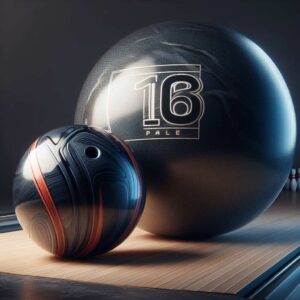If you’re new to the world of bowling or simply prefer a more predictable ball motion, plastic bowling balls are an excellent choice.
Unlike their reactive resin counterparts, these balls are designed to provide a straighter and more controlled path down the lane, making them ideal for beginners or those seeking consistency.
In this comprehensive guide, we’ll delve into the intricacies of plastic bowling balls, covering everything from their unique coverstocks to drilling layouts and maintenance.
Understanding Plastic Bowling Ball Coverstocks
At the core of a plastic bowling ball’s performance lies its coverstock material. These balls are typically crafted with a polyester or similar plastic compound, which creates a smooth, non-porous surface that doesn’t absorb lane oil as readily as reactive resin balls.
One of the primary advantages of plastic coverstocks is their predictability. Unlike reactive resin balls, which are designed to create friction and generate hook when they encounter oil on the lane, plastic balls tend to skid more efficiently, resulting in a straighter ball path. This characteristic makes them ideal for beginners who are still developing their skills or for more experienced bowlers seeking a dependable spare ball or dry lane specialist.
While plastic coverstocks offer exceptional control and consistency, it’s important to note that they generally lack the hooking potential of their reactive resin counterparts. This trade-off means that plastic balls may not be the best choice for bowlers seeking aggressive hook or backend movement.
When to Use a Plastic Bowling Ball
Plastic bowling balls excel in several scenarios, making them a versatile addition to any bowler’s arsenal:
- For Beginners and Straight Ball Motion: If you’re new to the sport of bowling, a plastic ball can be an excellent starting point. Its predictable motion and lack of aggressive hooking tendencies make it easier to develop consistent release techniques and improve accuracy.
- On Dry Lane Conditions: When the lanes are particularly dry or oil-depleted, reactive resin balls may struggle to generate the desired hook, leading to over/under reactions. In these situations, a plastic ball’s straight trajectory can provide a reliable and controllable alternative.
- As a Spare Ball: Many experienced bowlers rely on plastic balls as their go-to spare ball. The straight motion and consistency of plastic balls make them ideal for picking up single-pin spares, especially when precision is paramount.
- When Control is Prioritized: In certain situations, such as when bowling on sport or challenging patterns, sacrificing hook potential for increased control can be advantageous. Plastic balls excel in these scenarios, allowing bowlers to play straighter lines and make smaller adjustments to their targeting and release.
Choosing the Right Plastic Ball
With a variety of plastic bowling ball options available on the market, selecting the right one for your game can be a daunting task. Here are some key factors to consider:
- Weight Considerations: Like any bowling ball, the weight of a plastic ball is a crucial factor. Ideally, you should choose a weight that allows you to generate enough revolutions and ball speed without compromising your form or risking injury. Most bowlers opt for balls ranging from 14 to 16 pounds.
- Coverstock Options: While all plastic balls share a similar non-porous coverstock composition, manufacturers offer various surface finishes and polishes. For example, a dull plastic ball may provide more traction and a slightly arcing motion, while a polished plastic ball will skid more efficiently for a straighter trajectory.
- Core Dynamics and Stats: Despite their reputation for straight ball motion, plastic balls can still exhibit varying degrees of hook potential based on their core designs. Pay attention to factors like differential (high differentials promote more flare potential) and intermediate differential (higher values can create a smoother, more controlled backend motion).
- Top Plastic Ball Models and Brands: Some popular plastic ball models to consider include the Storm Hy-Road, Brunswick T-Zone, Ebonite Maxim, and Hammer Black Widow Legend. These balls have garnered praise from bowlers of all skill levels for their performance and consistency.
Drilling Layouts for Plastic Balls
While the coverstock material plays a significant role in a plastic ball’s motion, the drilling layout can also influence its trajectory and overall performance. Here are some common drilling layouts for plastic balls:
- Common Layouts for Straight Ball Motion: For a truly straight ball motion, many bowlers opt for a basic layout with a low or medium-low differential. This configuration minimizes track flare and promotes a smooth, predictable roll.
- Impact of Hand Position, Span, and Track: Even with a straight ball, adjusting elements like hand position (where the grip is placed relative to the core), span (distance between thumb and finger holes), and track (angle of the VAL line) can subtly influence the ball’s motion. Experimenting with these factors can help fine-tune the ball’s behavior to suit your individual style and preferences.
- Balancing Hook Potential and Controllability: While plastic balls are known for their straight motion, some bowlers may desire a slight arcing or backend movement. In these cases, layouts with higher differential values or more aggressive drilling angles can be employed to introduce a controlled amount of hook potential without sacrificing too much predictability.
How to Hook a Plastic Ball
Despite their reputation for straight trajectories, it is possible to create some hook with a plastic ball. Here are a few techniques to consider:
- Increase Entry Angle: One way to promote more hook is to increase your entry angle into the pocket. This can be achieved by adjusting your footwork, release, or targeting to create a sharper entry angle, which can generate more friction and backend movement.
- Surface Adjustments: While plastic balls generally lack the aggressiveness of reactive resin coverstocks, you can still manipulate the surface to influence traction. Techniques like sanding or applying a dull finish to the ball can create more friction and promote a slightly arcing motion.
- Loft Considerations: Loft, or the amount of air a ball gets off the lane, can also impact hook potential. Increasing your rev rate and ball speed can generate more loft, which can contribute to a more pronounced backend hook.
- When to Sacrifice Hook for Control: It’s important to remember that plastic balls are designed for control and consistency. While introducing some hook potential can be beneficial in certain situations, it’s crucial to strike a balance and not sacrifice too much of the ball’s predictable nature.
Care and Maintenance
Proper care and maintenance are essential for ensuring your plastic bowling ball performs at its best for years to come. Here are some tips to keep in mind:
- Cleaning and Resurfacing: Regular cleaning is crucial for maintaining a plastic ball’s surface integrity and preventing the buildup of dirt, oil, and other contaminants that can impact performance. Additionally, periodic resurfacing through sanding or polishing can restore the ball’s desired surface texture and finish.
- Storage Best Practices: When not in use, store your plastic balls in a cool, dry environment away from direct sunlight or extreme temperatures. Proper storage can prevent premature degradation of the coverstock material.
- When to Replace a Plastic Ball: While plastic balls are known for their durability, they will eventually wear down over time, especially with frequent use. Signs that it may be time to replace your plastic ball include visible cracks or chips in the coverstock, significant loss of surface texture, or a noticeable decrease in overall performance.
Conclusion
Plastic bowling balls offer a unique combination of control, consistency, and predictability, making them an invaluable asset for bowlers of all skill levels.
Whether you’re a beginner seeking a forgiving introduction to the sport, an experienced bowler in need of a reliable spare ball, or someone who values precision over aggressive hook, plastic balls can be the perfect addition to your arsenal.
When selecting a plastic ball, consider factors like weight, coverstock finish, core dynamics, and drilling layouts to find the perfect fit for your individual game.
And remember, while plastic balls are known for their straight ball motion, there are techniques and adjustments that can introduce a controlled amount of hook when desired.
Proper care and maintenance, including regular cleaning and resurfacing, will ensure your plastic ball remains in top condition for years to come.
So, whether you’re looking to improve your spare game, conquer challenging lane conditions, or simply enjoy the consistency and control of a straight ball motion, embrace the versatility and reliability of plastic bowling balls.





